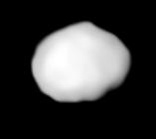Astronomy:88 Thisbe
 | |
| Discovery | |
|---|---|
| Discovered by | Christian Heinrich Friedrich Peters |
| Discovery date | June 15, 1866 |
| Designations | |
| (88) Thisbe | |
| Pronunciation | /ˈθɪzbiː/[1] |
| Named after | Thisbē |
| Minor planet category | Main belt |
| Adjectives | Thisbean /θɪzˈbiːən/, /ˈθɪzbiən/ |
| Orbital characteristics[2] | |
| Epoch December 31, 2006 (JD 2454100.5) | |
| |{{{apsis}}}|helion}} | 482.242 Gm (3.224 AU) |
| |{{{apsis}}}|helion}} | 345.809 Gm (2.312 AU) |
| 414.025 Gm (2.768 AU) | |
| Eccentricity | 0.165 |
| Orbital period | 1,681.709 d (4.60 yr) |
| Mean anomaly | 165.454° |
| Inclination | 5.219° |
| Longitude of ascending node | 276.765° |
| 36.591° | |
| Physical characteristics | |
| Dimensions | c/a = 0.81±0.07[3] (255×232×193)±12 km[4] |
| Mean diameter | 218±3 km[3] 225 km[4] 232 km (Dunham)[2] |
| Mass | (11.6±2.2)×1018 kg[3] 18.3×1018 kg[4] 1.5×1019 kg[5][6] |
| Mean density | 2.14±0.42 g/cm3[3] 3.06±0.52 g/cm3[4] |
| Rotation period | 6.04[7] h |
| Geometric albedo | 0.057[3] 0.067[8] |
| B [2] | |
| Absolute magnitude (H) | 7.04[2] |
Thisbe, minor planet designation 88 Thisbe, is the 13th largest main-belt asteroid. It was discovered by C. H. F. Peters on June 15, 1866, and named after Thisbe, heroine of a Roman fable. This asteroid is orbiting the Sun at a distance of 2.768 AU with a period of 4.60 years and an orbital eccentricity (ovalness) of 0.165. The orbital plane is inclined at an angle of 5.219° to the ecliptic.
On October 7, 1981, asteroid 88 Thisbe was observed to occult the 9th-magnitude star SAO 187124 from 12 sites. The timing of the different chords across the asteroid provided a diameter estimate of 232±12 km. This is 10% larger than the diameter estimate based on radiometric techniques.[9][10][11] During 2000, 88 Thisbe was observed by radar from the Arecibo Observatory. The return signal matched an effective diameter of 207 ± 22 km. This is consistent with the asteroid dimensions computed through other means.[12]
Photometric observations of this asteroid during 1977 gave a light curve with a period of 6.0422 ± 0.006 hours and a brightness variation of 0.19 in magnitude.[7]
Perturbation
Thisbe has been perturbed by asteroid 7 Iris and in 2001 Michalak estimated it to have a mass of 15×1018 kg.[5][6] But Iris is strongly perturbed by many minor planets such as 10 Hygiea and 15 Eunomia.[5]
In 2008, Baer estimated Thisbe to have a mass of 10.5×1018 kg.[4] In 2011 Baer revised this to 18.3×1018 kg with an uncertainty of 1.1×1018 kg.[4]
References
- ↑ Noah Webster (1884) A Practical Dictionary of the English Language
- ↑ 2.0 2.1 2.2 2.3 Yeomans, Donald K., "88 Thisbe", JPL Small-Body Database Browser (NASA Jet Propulsion Laboratory), https://ssd.jpl.nasa.gov/sbdb.cgi?sstr=88, retrieved 2013-03-25.
- ↑ 3.0 3.1 3.2 3.3 3.4 P. Vernazza et al. (2021) VLT/SPHERE imaging survey of the largest main-belt asteroids: Final results and synthesis. Astronomy & Astrophysics 54, A56
- ↑ 4.0 4.1 4.2 4.3 4.4 4.5 Jim Baer (2011). "Recent Asteroid Mass Determinations". Personal Website. http://home.earthlink.net/~jimbaer1/astmass.txt.
- ↑ 5.0 5.1 5.2 Michalak, G. (2001). "Determination of asteroid masses". Astronomy & Astrophysics 374 (2): 703–711. doi:10.1051/0004-6361:20010731. Bibcode: 2001A&A...374..703M. https://www.aanda.org/articles/aa/full/2001/29/aa10228/aa10228.html. Retrieved 2008-11-06.
- ↑ 6.0 6.1 (Low mass estimate of Thisbe 0.074 / Mass of Ceres 4.75) * Mass of Ceres 9.43×1020 = 1.47×1019
- ↑ 7.0 7.1 Schober, H. J. et al. (April 1979), "Photoelectric photometry and rotation periods of three large and dark asteroids - 49 Pales, 88 Thisbe and 92 Undina", Astronomy and Astrophysics Supplement Series 36: pp. 1–8, Bibcode: 1979A&AS...36....1S.
- ↑ Asteroid Data Sets
- ↑ Millis, R. L. et al. (February 1983), "The diameter of 88 THISBE from its occultation of SAO 187124", Astronomical Journal 88: 229–235, doi:10.1086/113310, Bibcode: 1983AJ.....88..229M.
- ↑ Taylor, G. E., "Progress in accurate determinations of diameters of minor planets", Asteroids, comets, meteors; Proceedings of the Meeting, Uppsala, Sweden, June 20–22, 1983: pp. 107–109, Bibcode: 1983acm..proc..107T.
- ↑ Observed minor planet occultation events, version of 2005 July 26
- ↑ Magri, Christopher et al. (January 2007), "A radar survey of main-belt asteroids: Arecibo observations of 55 objects during 1999–2003", Icarus 186 (1): 126–151, doi:10.1016/j.icarus.2006.08.018, Bibcode: 2007Icar..186..126M
External links
- 88 Thisbe at AstDyS-2, Asteroids—Dynamic Site
- 88 Thisbe at the JPL Small-Body Database
 |

